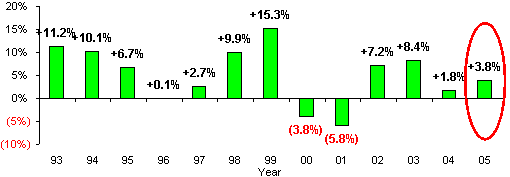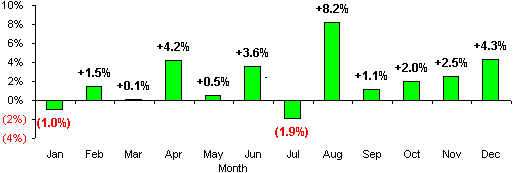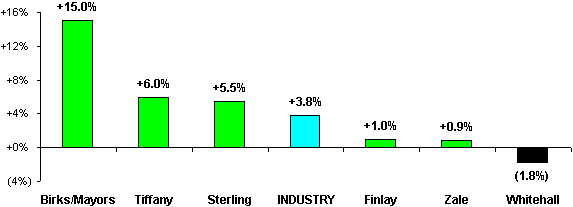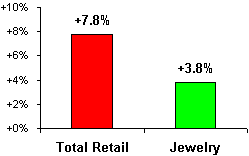IDEX Online Research: Holiday Selling Season Jewelry Sales End On a High Note
February 19, 06
The 2005 holiday selling season was a nail-biter for U.S. jewelers. Momentum started slowly, but built with each successive month. By December, jewelers were reporting stronger sales as each day passed. The week after Christmas was one of the strongest periods, and it helped save the season for many jewelers.
For the all-important selling season – November-December – U.S. holiday sales were up 3.8 percent. This was in line with initial forecasts by IDEX Online Research, though we had toned down our expectations based on an excruciatingly slow start to the season. The graph below summarizes final results for the 2005 selling season versus prior years.
| U.S. Jewelry Sales Trends - Holiday Selling Season |
2005 Jewelry Demand Was Volatile
Sales trends early in the year gave no hints about prospects for the all-important 2005 holiday selling season. One month would be strong, followed by very weak sales, as the graph below illustrates.
| U.S. Jewelry Sales Trends - 2005 |
In July, U.S. jewelry sales actually fell below the prior year’s level, only to spike upward sharply in August. This was the worst time of year for such volatility and uncertainty, since most jewelers were finalizing their jewelry orders for the holiday season. Explanations abound about these sales aberrations, but no one has been able to come up with a plausible reason for 2005’s unusual volatility of demand.
August and September demand was buffeted by natural disasters – three hurricanes battered U.S. coastal regions, with their ripples reaching far inland. As expected, September sales were weak, though not as weak as some had predicted.
Beginning in October, jewelry sales momentum began to build. November sales trends were hopeful, but it was not until December that the full force of American shoppers swept over the jewelry industry. And, actually, it was not until the final few days prior to Christmas – as well as the post-Christmas week – before jewelry sales swelled.
Jewelry Demand Was Polarized
Jewelry demand, especially in the holiday selling season, was polarized: high-end jewelers posted the strongest results while most mass market jewelers generated only marginal gains. Kay Jewelers was a notable exception, as the following and summary illustrate.
| 2005 Holiday Same-Store Sales Trends |
- Birks & Mayors – Birks & Mayors, with stores in both the U.S. and Canada, posted a solid 15 percent total sales gain in the 2005 holiday period. Same-store sales were also up 15 percent. All gains are constant-currency. In “reported” dollar sales, both total revenues and same-store sales were up 17 percent.
- Tiffany & Co. – World-renowned luxury jeweler Tiffany & Co. reported that total U.S. retail sales were up 8 percent, with a 6 percent same-store sales gain. Tiffany noted that same-sales in the U.S. were up 4 percent in November and rose by 7 percent in December. Sales in its New York flagship store were down 1 percent for the two-month period, but rose by 3 percent in December. The transit strike in New York hurt sales in the flagship store. Tiffany’s branch stores around New York posted a 3 percent sales gain; all U.S. branch sales were up 8 percent in the November-December period. The total number of transactions rose in the holiday selling period. Further, Tiffany management noted that its biggest gains came from jewelry priced at over $50,000 retail. Other popular products included rings, studs, bracelets, necklaces, colored diamonds, men’s jewelry, band rings, core fine jewelry, and colored stone jewelry.
- Sterling Jewelers (Kay, Jared, and regional brands) – Total sales up 10.5 percent; same-store sales up 5.5 percent. All gains are constant currency. Mall stores account for about 80 percent of the same-store sales results, but management noted that sales in the Jared superstore division were particularly strong. Sterling noted that its U.S. gross margin is under pressure due to cost increases and mix; however, as a result of strong sales and expense controls, profits are well ahead of the prior year.
- Finlay Enterprises – Total holiday sales were up 9.9 percent for Finlay, the operator of leased jewelry departments in major U.S. department stores as well as the recently-acquired Carlyle jewelry chain. Carlyle sales distorted reported total sales gains since it was acquired during the year. Further, sales in the 196 units slated to be discontinued (related to Federated’s merger with May) also distorted results. On a comparable basis, same-store sales in “going-forward” units increased by 1.0 percent. If results from the 196 discontinued units (related to Federated’s merge with May) are included, same-store sales declined by 0.6 percent for Finlay. After a softer than expected November, sales in Finlay’s core “going-forward” store base rebounded in December and the holiday season finished on a positive note.
- Zale Jewelers – Zale reported that total sales rose by 1.4 percent for the 2005 holiday selling season, with same-store sales up 0.9 percent. Comparable store sales accelerated during the two-month period. November same-store sales decreased approximately 6 percent while December comparable store sales increased over 3 percent. Gordon’s Jewelers, Bailey Banks & Biddle Fine Jewelers, Zales Outlet, and Zale Canada (Peoples Jewellers and Mappins Jewellers) each posted a 6 percent or greater same-store sales increase for the two-month period while Zales Jewelers and Piercing Pagoda combined for a comparable store sales decline of approximately 4 percent.
- Whitehall Jewellers – Total sales were essentially flat at Whitehall, while same-store sales slipped by a very modest 0.3%. During the November/December period, Whitehall ran store closing/ inventory liquidation sales in the 77 stores it plans to close. Sales in those stores increased 10.1 percent to $15.2 million. These stores were to be closed by the end of January 2006. Comparable store sales in ongoing stores for the November/December period decreased 1.8 percent.
Jewelers’ Profits Mixed
Among the publicly held jewelers who reported holiday results, some were mum on profits while others elected to give guidance, as follows:
- Tiffany & Co. – Profits for the fourth quarter and full year will be at the high end of its earlier guidance.
- Zale Corporation – Profits will be under pressure due to weaker-than-expected sales. Management had been planning for a same-store sales gain of 2-3 percent in the holiday selling season.
- Sterling – Operating profits in Signet’s U.S. division will be well ahead of last year.
- Finlay Enterprises – Management has revised profit expectations downward.
Internet Holiday Sales Trends Mixed
While holiday and fourth quarter sales and profit statistics are still being tabulated, IDEX Online Research has summarized trends to date in two separate articles: Blue Nile Sales & Profit Growth Moderates in Q4 and Internet Jewelry Sales: Ouch?.
What Affected Jewelry Demand in the 2005 Holiday Season?
There were a multitude of factors which had an impact on jewelry demand, including the following:
Positives:
- Lower unemployment
- Rising personal wages and income
- Lack of one-time unusual events such as terrorism and natural disasters
- Generally favorable weather
- Falling gasoline prices
- Lack of more energy price spikes for heating oil and natural gas
- Strong consumer balance sheets
- Improved mall traffic
- Stable jewelry prices
| U.S. Jewelers Lost Market |
- Too much competition at the all-important $300 price point from iPods and other electronic gizmos
- Lack of new exciting jewelry merchandise
- Lack of aspirational brands in the jewelry industry
- Rising interest rates
- Moderating home prices (consumers didn’t feel as wealthy)
- Lack of one-time cash inflows (from tax rebates, etc.)
- Rising consumer debt burden
- Unfavorable shopping calendar (Christmas on a Monday)
- Aggressive price-based promotions kept consumers waiting for better deals
U.S. Retail Sales Trends
2005 Holiday Selling Season
% Change Y/Y
Jewelry All Retail December
+4.3%
+7.2%
Holiday (Nov/Dec) +3.8%
+7.8%
Fourth Quarter +3.5%
+8.5%
Full Year +2.5%
+8.4%
Source: U.S. Dept. of Commerce
Jewelers Lost Market Share
| U.S. Retail Sales Trends
|
While jewelry sales were strong in the holiday selling season, they were below the gains that the total retail industry posted. This means that U.S. jewelers lost share-of-wallet to other merchants. The graph at right summarizes the disparity between 2005 holiday jewelry sales and total retail sales (all categories except auto and food). The “total retail” sales gain does not necessarily correlate to other numbers (for example, the NRF says holiday sales were up 6.4 percent), but the differences relate to how holiday sales are defined. IDEX Online Research uses U.S. Department of Commerce data.
The table at right summarizes jewelry industry sales trends for December 2005, the 2005 holiday selling period (November-December), fourth quarter, and full year compared with all retail categories (except autos and food). Jewelers lost market share during each of these four periods.



